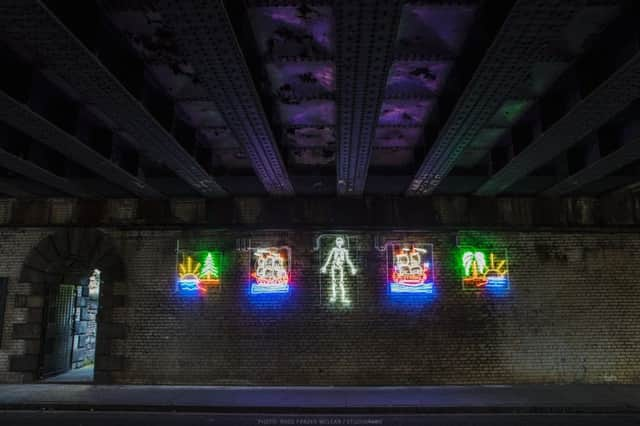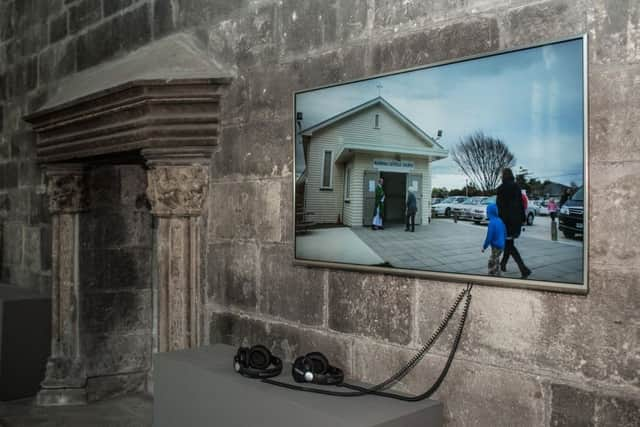Arts review: More Lasting Than Bronze | Jonathan Owen


More Lasting Than Bronze | Various locations, Edinburgh
Jonathan Owen | Ingleby Gallery, Edinburgh
I f there is indeed a darkness to Edinburgh’s light, a Mr Hyde to its Dr Jekyll, I can tell you exactly where to find it. It is under the railway bridge at the junction of New Street and Calton Road, in the dark canyon at the bottom of the steep steps known as Jacob’s Ladder that take you from the old town to the new and, by analogy, from earth to heaven.


At the top of those steps you’ll find the grand architecture of Regent’s Road. At the bottom, you’ll find darkness, graffiti, abandoned canisters of lighter fluid and now, unexpectedly, a wonderful new neon artwork from Graham Fagen, entitled A Drama in Time (****). The artist has created five neon signs centred on the story of the Roselle, a ship that sailed from the Port of Leith to Kingston, Jamaica in 1786. Robert Burns had booked a passage on the boat, but dropped out at the last minute. Had he gone he planned to become an overseer of slaves on a sugar plantation.
Advertisement
Hide AdAdvertisement
Hide AdFagen’s work is part of More Lasting Than Bronze, EAF director Sorcha Carey’s sequence of seven public artworks on the theme of the monument, timed perfectly in a year in which the centenary of events such as Jutland, the Somme and the Easter Rising have all raised questions about how and why we remember. Carey’s strength as a curator in recent festivals has been her ability to open up: both physically, using some of Edinburgh’s hidden or forgotten spaces and emotionally, in her understated insistence on tackling unspoken subjects.
Climb Jacob’s Ladder and once you’ve recovered your breath you’ll see the Burns Monument, a tiny neoclassical temple by Thomas Hamilton. It lost its heart less than a decade after it was opened in 1831, when a statue of Burns by John Flaxman was whisked away because of fears of smoke damage from a nearby Gasworks. Here Edinburgh artist Jonathan Owen has made the best work of his career to date, the transformation by his own hand of a 19th century marble statue of an artfully nude nymph. Since he graduated from Edinburgh College of Art in 2000, Owen has specialised in absences, taking away or modifying existing images and objects to tell new stories. For this untitled work (*****) he has carved a series of central links from the centre of the statue, so the nymph’s head has dropped in despondency and her belly and spine is a chain, a sign of her enslavement to the male gaze and a beautifully strange revelation of the stone emptiness at the heart of the image.
Along the road the Ingleby Gallery has returned to its former roots, re-opening its small, domestic gallery at 6 Carlton Terrace. It is a lovely setting for their show of Owen’s elegant and eerie “drawings” of photographs altered to change their central narratives, by the artful use of an eraser (***).


There is loss too, In Olivia Webb’s Voices Project (***), first created as a response to the Christchurch Earthquakes in 2011 in which 185 people died. Her soundwork records three amateur choirs, whose voices start hesitantly in rehearsal but come together in glorious harmony, filling the empty shell of Trinity Apse with hope.
The sounds are less reassuring but perhaps more deeply expressed in the Pakistani artist Bani Abidi’s Memorial to Lost Words (****), a heart-breaking dialogue of musical voices set in the debating chamber at the Old Royal High School. It sets a Punjabi folk song in which women beg their men not to serve in the war, with a male lament, based on the letters and memoirs of the Indian servicemen from the Western Front.
The First World War emphasis on this part of the programme extends down to Leith where Ciara Phillips has transformed the MV Fingal at Prince of Wales Dock with a sweep of colour and contour in tribute to the so-called dazzle ships, whose painted hulls were designed to visually confound their pursuers. The work, entitled Every Woman (***), is in tribute to the women telegraph operators and indeed the women artists whose war effort is often un-noticed.
James Connolly was not so much un-noticed as hidden, a barely whispered name in the Presbyterian Edinburgh I grew up in. Born in the Cowgate in 1868 and executed in 1916 as one of the leaders of Dublin’s Easter Rising, Connolly was a complicated and hugely important historical figure, a socialist, labour activist, educator and agitator who eventually hung his coat on the nationalist peg. His legacy (which is complex and clouded) is barely acknowledged here.
Advertisement
Hide AdAdvertisement
Hide AdRoderick Buchanan’s film Understanding Versus Sympathy (***) is shown in a war memorial side chapel in St Patrick’s Church, in the Cowgate where Connolly was baptised. Connolly’s life and impact is explained by Owen Dudley Edwards, the Edinburgh historian, who is featured as a single talking head in a film that lasts an hour and half. It is a bravura performance with moments of clear analysis and almost folkloric storytelling: it is a portrait of the speaker as much as it ever can be of the long-dead and long-contested Connolly. Dudley Edward’s father once met Connolly: the revolutionary had just fallen on his back after a friendly tug of war at a Dublin school.
Connolly’s father was a carter, which means his job was to shovel dung from the streets. The historian describes what it must have been like to look up from the dark gully of the Cowgate to see the characters of a more affluent Edinburgh cross the showpiece architecture of George IV Bridge: it was, says Dudley Edwards, “the class struggle in stone.”
• The Edinburgh Art Festival runs until 28 August. For full programme details visit www.edinburghartfestival.com